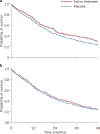Next generation oncology drug development: opportunities and challenges
- PMID: 19390552
- PMCID: PMC7079165
- DOI: 10.1038/nrclinonc.2009.38
Next generation oncology drug development: opportunities and challenges
Abstract
The optimal development of novel molecularly targeted agents for the treatment of cancer requires a re-evaluation of the current drug development paradigm. Selection of patients, optimal biologic dose versus maximum tolerated dose, definition of response and clinical benefit and trial designs that address these considerations are the focus of debate in the field of early cancer therapeutics. We present a review of the opportunities and challenges facing drug development in oncology through the phases of clinical development starting with first-in-human trials.
Figures


Similar articles
-
Challenges of phase 1 clinical trials evaluating immune checkpoint-targeted antibodies.Ann Oncol. 2016 Feb;27(2):214-24. doi: 10.1093/annonc/mdv550. Epub 2015 Nov 16. Ann Oncol. 2016. PMID: 26578728 Review.
-
Revisiting the definition of dose-limiting toxicities in paediatric oncology phase I clinical trials: An analysis from the Innovative Therapies for Children with Cancer Consortium.Eur J Cancer. 2017 Nov;86:275-284. doi: 10.1016/j.ejca.2017.09.015. Epub 2017 Oct 19. Eur J Cancer. 2017. PMID: 29055843
-
Current issues in dose-finding designs: A response to the US Food and Drug Adminstration's Oncology Center of Excellence Project Optimus.Clin Trials. 2024 Jun;21(3):267-272. doi: 10.1177/17407745241234652. Epub 2024 Apr 3. Clin Trials. 2024. PMID: 38570906 Free PMC article.
-
Dose escalation methods in phase I cancer clinical trials.J Natl Cancer Inst. 2009 May 20;101(10):708-20. doi: 10.1093/jnci/djp079. Epub 2009 May 12. J Natl Cancer Inst. 2009. PMID: 19436029 Free PMC article. Review.
-
Dose-finding designs for trials of molecularly targeted agents and immunotherapies.J Biopharm Stat. 2017;27(3):477-494. doi: 10.1080/10543406.2017.1289952. Epub 2017 Feb 6. J Biopharm Stat. 2017. PMID: 28166468 Free PMC article.
Cited by
-
Molecular Pharmacodynamics-Guided Scheduling of Biologically Effective Doses: A Drug Development Paradigm Applied to MET Tyrosine Kinase Inhibitors.Mol Cancer Ther. 2018 Mar;17(3):698-709. doi: 10.1158/1535-7163.MCT-17-0552. Epub 2018 Feb 14. Mol Cancer Ther. 2018. PMID: 29444985 Free PMC article.
-
Modeling NSCLC progression: recent advances and opportunities available.AAPS J. 2013 Apr;15(2):542-50. doi: 10.1208/s12248-013-9461-y. Epub 2013 Feb 13. AAPS J. 2013. PMID: 23404126 Free PMC article.
-
Synergistic cytotoxic effects of inorganic phosphate and chemotherapeutic drugs on human osteosarcoma cells.Oncol Rep. 2013 May;29(5):1689-96. doi: 10.3892/or.2013.2306. Epub 2013 Feb 26. Oncol Rep. 2013. PMID: 23446517 Free PMC article.
-
Multiple gene dysfunctions lead to high cancer-susceptibility: evidences from a whole-exome sequencing study.Am J Cancer Res. 2011;1(4):562-73. Epub 2011 Mar 30. Am J Cancer Res. 2011. PMID: 21984973 Free PMC article.
-
First-line single-agent regorafenib in frail patients with metastatic colorectal cancer: a pilot phase II study of the Spanish Cooperative Group for the Treatment of Digestive Tumours (TTD).BMC Cancer. 2019 Jun 3;19(1):533. doi: 10.1186/s12885-019-5753-7. BMC Cancer. 2019. PMID: 31159765 Free PMC article. Clinical Trial.
References
-
- Kola I & Landis J Can the pharmaceutical industry reduce attrition rates? Nat. Rev. Drug Discov. 3, 711–716 (2004). - PubMed
-
- Fox E et al. Clinical Trial Design for Target-Based Therapy. Oncologist 7, 401–409 (2002). - PubMed
-
- [No authors listed] Steps to consider in pharmacodynamic assay development http://dtp.nci.nih.gov/docs/phase0/PharmacoDynamicAssayDeveloment.html (accessed 25 september (2008).
-
- Perez-Soler R et al. Determinants of tumor response and survival with erlotinib in patients with non-small-cell lung cancer. J. Clin. Oncol. 22, 3238–3247 (2004). - PubMed
Publication types
MeSH terms
Substances
Grants and funding
LinkOut - more resources
Full Text Sources

